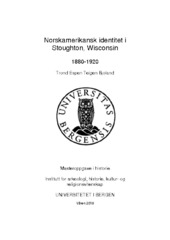Norskamerikansk identitet i Stoughton, Wisconsin. 1880-1920
Abstract
I 1825 startet en migrasjonsstrøm som førte hundretusener av nordmenn over Atlanterhavet i håp om en bedre fremtid i Amerika. Migrantene bosatte seg både i eksisterende og nyetablerte lokalsamfunn, og over tid har de både påvirket og blitt påvirket av samfunnet de ble en del av. Denne masteroppgaven undersøker de norske immigrantenes rolle i utviklingen av lokalsamfunnet i småbyen Stoughton i Wisconsin, som rundt år 1900 hadde en majoritet av innbyggere med bakgrunn fra Norge. Studien forsøker å undersøke hvordan en norskamerikansk etnisk koloni ble utviklet i byen i perioden 1880 til 1920. Ved undersøkelse av konkrete kulturelle trekk følges denne utviklingen i en spennende del av byens historie, og studien kan dermed gi svar på interessante spørsmål om norskamerikansk identitet i Stoughton. Between 1825 and 1930, hundreds of thousands of Norwegians crossed the Atlantic Ocean in the hope of a better future in America. The migrants spread across the American continent, and settled in different forms of local communities. Over time they have influenced, and been influenced by, the communities they became a part of. In this Master’s thesis, I have studied the small town of Stoughton in Wisconsin, where immigrants from Norway constituted a majority of the population around 1900. The purpose is to investigate how the Norwegian-American ethnic identity was maintained and developed from 1880 to 1920 in what could be described as an ethnic colony, by studying specific cultural elements in the town. These elements included social organizing in religious context, political participation, usage of the Norwegian language and ethnic celebration. The terms “pluralism” and “assimilation” are important in the thesis, because the continuation and development of cultural elements inspired by Norway may have influenced the immigrant’s ethnic identity. My study have shown that pluralism and assimilation existed simultaneously in the investigated period, because variations of some cultural elements were maintained at least until 1920, while others were developed and adapted between 1880 and 1920. This is particularly easily identifiable in the usage of the Norwegian language. Inhabitants in Stoughton used Norwegian during the whole period, but English became increasingly used among the immigrants in the years leading up to 1920. Celebration of the Norwegian Constitution Day on May 17th is also an important part of understanding the inhabitant’s collective identity. In the early period, the constitution day was celebrated in small private gatherings, while towards the end of the period, citywide celebrations were organized. These included all inhabitants, and were not limited to the Norwegian-American ethnic group. This development shows a transition from a Norwegian identity to a more symbolic Norwegian-American one. Thus, the conclusions of the thesis highlight the emergence of a new local identity across ethnic divisions, with local patriotism connected to Stoughton’s Norwegian-American history.
